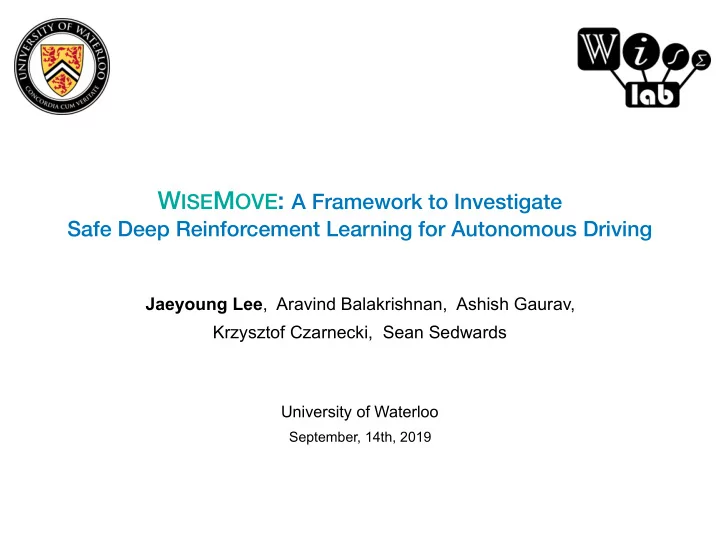

W ISE M OVE : A Framework to Investigate Safe Deep Reinforcement Learning for Autonomous Driving Jaeyoung Lee , Aravind Balakrishnan, Ashish Gaurav, Krzysztof Czarnecki, Sean Sedwards University of Waterloo September, 14th, 2019
1 W ISE M OVE ? ‣ A research platform that mimics our autonomous driving stack. ‣ Objective: investigate the safety and performance of motion planners trained using deep reinforcement learning ‣ Features: ✓ Hierarchical Decision Making ✓ Runtime Verification ✓ Reinforcement Learning / Monte Carlo Tree Search (MCTS)
2 Motion Planning Architecture in 100 km Public Drive (2018) Motion Planner No learning component … (abstracted) Behaviour Planner high-level decision Local Planner reference trajectories measurements, perceptions, etc.
3 W ISE M OVE Architecture Deep models are trained by Motion Planner (w/o MCTS) deep reinforcement learning. Deep Model for Decision Making Option (high-level decision) Deep Model for Trajectory Generation reference trajectories Road Scenario stop region STOP ego measurements, stop region intersection perceptions, etc. STOP
4 W ISE M OVE Architecture Motion Planner (w/o MCTS) Deep Model for Decision Making Option Road Scenario ‣ Five Options: KeepLane, Stop, Wait, Follow, ChangeLane stop region ‣ Components STOP ego ✓ speed limit, target lane stop region intersection ✓ time-out (e.g., 1 sec.) STOP ✓ preconditions , e.g., in an option ‘Wait’, ‣ Two “two-lane and one-way” roads G((has_stopped_in_stop_region ‣ All-ways stop implemented by the stop region and in_stop_region) U highest_priority) ‣ 0~5 other vehicles Deep Model for Trajectory Generation
5 W ISE M OVE Architecture Motion Planner (w/o MCTS) Deep Model for Decision Making Runtime Verifier Road Scenario ‣ Checks LTL-like strings until violated. stop region STOP ✓ preconditions, e.g., in an option ‘Wait’, ego stop region intersection G((has_stopped_in_stop_region and in_stop_region) U highest_priority) STOP ‣ An episode ends when: ✓ tra ffi c-rules, e.g., in a stop region, ✓ Ego reaches the right end on the road, G(in_stop_region => ✓ a tra ffi c rule is violated, or (in_stop_region U has_stopped_in_stop_region)) ✓ a collision happens. Deep Model for Trajectory Generation
6 W ISE M OVE Architecture Motion Planner (w/o MCTS) Deep Model for Decision Making ‣ Choose the ‘best’ Option. Input: a state representation Output: the learnt ‘best’ Option ‣ Act upon the termination of the current Option. Option (high-level decision) Next Option? Deep Model for Trajectory Generation
7 W ISE M OVE Architecture Motion Planner (w/o MCTS) Deep Model for Decision Making Option (high-level decision) Next Option? Deep Model for Trajectory Generation ‣ A deep model is stored for each Option. Input: a state representation (simplified) Output: reference trajectories, given an Option ‣ Trajectories generated with simplified vehicle model.
8 W ISE M OVE Architecture Motion Planner (w/o MCTS) Deep Model for Decision Making Option “ ” KeepLane Next Option? Follow Wait time Stop Deep Model for Trajectory Generation reference trajectory “____” To the road scenario
9 Training & Testing Low-level Deep Models ‣ Five Deep Models —one for each Option. ‣ Each model ✓ outputs continuous control commands generating the trajectories ✓ was trained by reinforcement learning (DDPG) with ✓ 20 sec. timeout ✓ (additional) preconditions and, if necessary, tra ffi c rules. Option “ ” Deep Model for Trajectory Generation reference trajectory “____”
10 After 100,000 steps training … KeepLane Stop Follow Wait
11 After 100,000 steps training … KeepLane mean (std) % success after 100,000 training Stop (averaged over 100 trials of 100 episodes) Follow Wait
12 After 1,000,000 steps training … KeepLane Stop Follow Wait
13 Training & Testing High-level Deep Model ‣ Each low-level deep model is trained a priori for 1,000,000 steps. ‣ One deep model, trained by reinforcement learning (DQN), outputs an Option. ‣ 1 sec. time-out for each option; 20 sec. time-out for an entire episode. Motion Planner (w/o MCTS) Deep Model for Decision Making Option “ ” Next Option? KeepLane Follow Wait time Stop Deep Model for Trajectory Generation reference trajectory “____” To the road scenario
14 Training & Testing High-level Deep Model Overall performance (after 200,000 steps training) (averaged over 1000 episodes)
15 With MCTS over Options … . . . Stop Traverse until the leaf node, Wait with exploration & exploitation ChangeLane KeepLane KeepLane KeepLane Wait ⊥ Simulate! . . . ChangeLane KeepLane current Wait Follow Stop Backpropagate! state Stop ChangeLane Stop Wait Follow Stop Overall performance (averaged over 1000 episodes)
16 Concluding Remarks ‣ Features: Options / Reinforcement Learning / Runtime Verification / Monte Carlo Tree Search (MCTS) ‣ The results are reproducible using the publicly available code at git.uwaterloo.ca/wise-lab/wise-move/ ‣ Future works ✓ Comparisons of RL and hand-coded motion planners. ✓ Di ff erent scenarios, realistic vehicle dynamics, etc. ✓ Simulation-to-Real
Thank you for attention! Q & A Acknowledgment This work is supported by the Japanese Science and Technology agency (JST) ERATO project JPMJER1603: HASUO Metamathematics for Systems Design, and by the Natural Sciences and Engineering Research Council of Canada (NSERC) Discovery Grant: Model-Based Synthesis and Safety Assurance of Intelligent Controllers for Autonomous Vehicles.
Recommend
More recommend